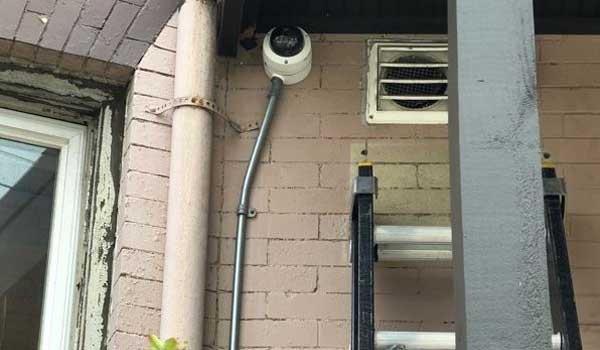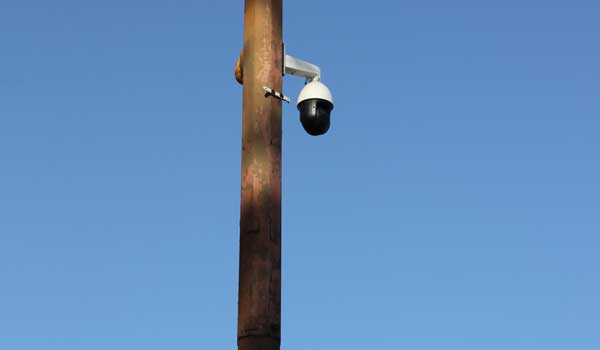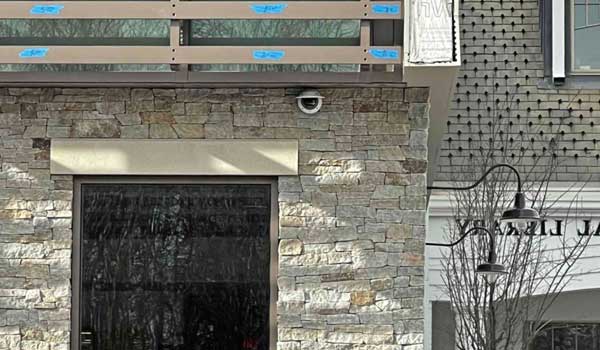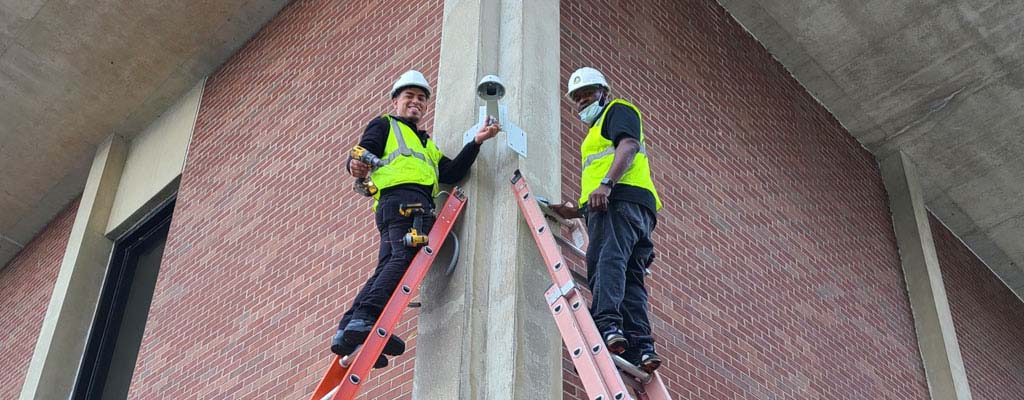Video MGMT System
 Access Control
Access Control
Voice & Data Wiring
 Burglar Alarm
Burglar Alarm
 Fire Alarm
Fire Alarm
Video MGMT System
Voice & Data Wiring
Choosing the right security cameras for your business or organization can be a daunting task, especially with the many options available.
This article will provide insights into two of the most popular cameras on the market: dome and pan tilt zoom cameras. By comparing these camera types, you'll better understand why you may select one type of camera for a particular need and placement instead of another.
Dome cameras, as the name implies, are encased in a dome-shaped housing. They offer fixed coverage, meaning their lens cannot be rotated or adjusted after installation.

Domes are designed to monitor a specific area continuously. Due to this fixed nature, they are excellent for coverage of areas like entrance gates, corridors, and rooms for storage space.
Their appearance also makes them the camera type best suited to most upscale settings and environments in which the cameras should blend into the background.
PTZ cameras, short for Pan, Tilt, and Zoom cameras, offer more flexibility in surveillance than most security cameras. Unlike fixed dome cameras, PTZ security cameras can rotate, tilt, and zoom in on particular areas or objects to provide variable surveillance fields of view.

PTZs have motorized components that enable users to adjust their view through apps and remote controls.
Both dome and PTZ security cameras come in models for surveillance outdoors, indoors, or both. However, between the two camera types, dome camera installations are often preferred for indoor security.
For smaller indoor spaces especially, the extensive coverage and advanced features of PTZ cameras might be overkill, and they may stand out aesthetically in a way that's undesirable.
Domes, on the other hand, blend well with most decors and, as a result, are often ideal for retail stores, restaurants, offices, lounges, and upscale settings.
If discreet surveillance to spot thieves and other bad actors is your priority, domes are often your best bet.
Aside from blending in with backgrounds, dome housings, especially "smoked" dome housings, can make it difficult to see where the camera is pointing. This obscuration is especially useful if you don't want people to be aware of the camera's focus.
For surveillance of areas prone to vandalism and other crimes, dome cameras are often the best camera choice because the protective dome housing makes it difficult for vandals to tamper with or damage the camera. In fact, many dome camera models are considered "vandal-proof" for their ability to withstand physical impact.
When considering dome vs. PTZs, consider the mounting placement you need for optimal coverage. With the help of a mounting bracket or a mounting handle, the camera base of PTZ security cameras can be attached to most surfaces, including walls, ceilings, and poles.

While a PTZ's mounting bracket or handle allows maximum flexibility when selecting a mounting location, a dome's mounting is directly attached to the back of the camera. This requires the camera to be fixed on a flat surface.
For indoor installations, domes can be mounted on their side, upside-down, and at an angle on any flat surface.
Dome cameras mounted outdoors, however, are a little bit more challenging.
Outdoor installations of domes should be flat and upside-down. This often requires a soffit or other overhang for the mounting house to be properly positioned. (Some outdoor dome cameras feature their own small visor-like shelters to enable sideways, vertical mounting.)
Outdoor domes that are mounted sideways instead of upside-down without visor-like shelters are prone to water pooling around their seals and freezing. When the water freezes, the seals are cracked, and internal camera components are exposed to the elements and ultimately destroyed.
If you need to track moving subjects, PTZ security cameras, with their pan, tilt, and optical zoom capabilities, offer the best solution. Most pan-tilt-zoom cameras can rotate 360 degrees. And their optical zoom feature allows them to zoom in on specific details, such as a person's face or a car's license plate, which can be very helpful during investigations.
A dome camera, on the other hand, would not be well-suited at all for tracking moving subjects across a large field of view because of their fixed lens and lack of motorized pan and tilt functionalities.
PTZs are often ideal for their ability to both pan and zoom across a wide landscape and focus on subjects of interest.

That said, if the pan tilt zoom camera is used for zooming or panning, portions of the area may be left uncovered, creating blind spots in the surveillance. Dome cameras are, therefore, often preferable for large-area surveillance with a fixed field of view.
Due to their ability to be manually controlled, PTZ security cameras are useful at live events or situations where subjects of interest are likely to move around, like concerts, sporting events, and traffic.
Dome cameras, due to their limited range, are less effective for monitoring dynamic spaces in which optical zoom and panning are required.
The zoom functionality of PTZs can capture details like faces and license plates from a distance, making this camera type ideal for high-security areas like banks, casinos, or government buildings. Dome cameras are unable to capture clear footage of objects in the distance.
If you want a camera that acts as a deterrent, the visibly larger PTZ cameras send a clear message to potential intruders that the area is being monitored. Dome cameras, on the other hand, are designed to be overlooked.
If you need detailed footage, PTZs are more suitable than domes due to the variable focal length of their lenses. This adjustability enables PTZs to capture high-resolution video footage at a variety of ranges or depths of field.
When choosing between domes and PTZ security cameras, it's essential to consider your specific needs, such as the size of the area to be surveilled, discretion and deterrence factors, the level of image detail required, and the amount of activity in the area being surveilled.

At Mammoth Security, we're experts in all things related to security cameras and their installation. We understand the intricacies involved in selecting the right camera for the right coverage, and we can customize the perfect camera system to make your site premises secure. Reach out to us today for a free consultation! Just fill out the simple form at the bottom of this page!
NOT COMPLETELY SURE?
860-748-4292The key difference between most PTZ and dome cameras lies in their functionality. Dome cameras offer fixed coverage, meaning they continuously monitor a specific area, while PTZ cameras offer variable surveillance coverage with their pan, tilt, and zoom capabilities.
Yes, both types of cameras have night vision capabilities. However, most PTZ cameras have more LED lights than most domes, enhancing their low-light night vision performance.
Both cameras work effectively in large indoor spaces. However, dome cameras offer a consistent fixed view of a particular area, while PTZ cameras are designed to rotate and zoom to cover more space in detail, but not all at once.
Absolutely, many models of dome cameras and pan-tilt-zoom cameras are designed to be weather-resistant, which makes them suitable for installations both outdoors and indoors.
Yes, PTZ cameras often come with smart motion detection features, enabling them to track and follow any movement within their field of view.
Yes, all IP cameras, including dome cameras and PTZ cameras, can be remotely accessed. Remote viewing capabilities on IP cameras allow users to monitor their premises from anywhere and at any time via easy-to-use apps.
When considering night vision capabilities for business surveillance, it's crucial to understand what dome and PTZ cameras offer. Both camera types often come equipped with LED lights and infrared LEDs for IR night vision.
PTZ cameras, on the other hand, offer dynamic coverage with their ability to move and capture footage at different angles, even in low-light conditions.
Dome cameras, on the other hand, usually have a shorter night vision distance. This is because they typically use their own IR LEDs to illuminate their field of view, which may not reach as far as some other types of cameras. The benefit is that dome cameras often provide higher-quality images in low-light conditions due to their dedicated light source.
Bullet cameras have an extended range that makes them ideal for monitoring long, straight distances, such as fence lines or outdoor corridors, to maintain perimeter security.
While each type of camera has its advantages and disadvantages, the best security systems use a combination of camera types that are strategically placed to match their strengths to specific surveillance needs.
The difference between bullet cameras and domes primarily lies in their design and field of view. Bullet cameras, also known as lipstick cameras, are much more noticeable than dome camera models, which makes a bullet camera preferable for deterrence purposes.
In contrast, dome cameras have a distinct dome shape that allows them to blend more seamlessly into their surroundings, making them less noticeable than bullet cameras.
Dome surveillance cameras also provide a wider viewing angle than bullet cameras, making them better for monitoring large, expansive areas.
Bullet video cameras are fixed cameras; once installed, their viewing direction is set, and adjustment requires special effort.
A PTZ can move its lens at the controller's discretion, offering a much more comprehensive and targeted view than a bullet camera.
When considering bullet vs. PTZ, remember that PTZ surveillance cameras offer dynamic control and coverage, while bullet cameras are relatively fixed in place.